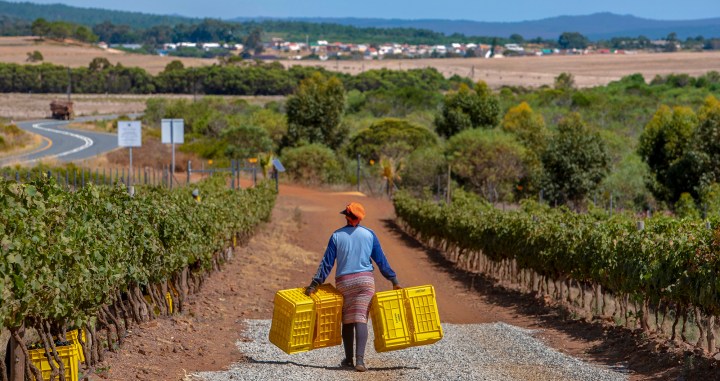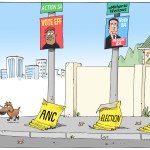FOOL’S GOLD
Mining prospecting application in Napier region threatens tourism, environment

‘I’m giving you a hint… I’m being friendly. Stop writing about it in the newspapers because you’re going to cause a gold rush.’
Landowners, tourist operators and other residents of the Agulhas Wine Triangle (AWT) are concerned about a mining application that they fear will lay waste to critically endangered renosterveld, local tourism and farming in the region.
The mining application – in the region encompassing Agulhas, Arniston, Caledon, De Hoop, Elim, Napier and Stanford in the Overberg – is curious because geologists say there is not enough gold in these hills to be viable.
Nevertheless, residents worry about the destruction that would be wrought by open-cast mining, which they say will alter this pristine conservation region for generations.
If approved, a company called Cienth will have exclusive rights for 30 years to explore about 4,200ha of farmland, with the intention of creating an enormous open-cast mine for gold, silver and tin ore.
The envisaged mine could potentially rip through the Overberg, generating noise pollution that will distress animals, kick up dust plumes that will coat crops on adjacent farms, and cause acid-mine drainage. Opponents of the mining development worry tourists, who once gravitated to the natural beauty and tranquillity of the Overberg, will also lose interest, while local jobs in tourism and farming will evaporate.
What’s at stake
At particular risk is the Nuwejaars Wetlands Special Management Area (NWSMA) which forms most of the catchment of the Nuwejaars River and connects with many wetlands that ultimately feed into the De Mond estuary – a Ramsar Site of International Importance. These sites are recognised as being of significant value not only for the countries in which they are located, but for humanity as a whole.
There are currently more than 2,400 Ramsar Sites around the world, covering over 2.5 million square kilometres – an area larger than Mexico.
The NWSMA conservation model is unique to South Africa. It stretches over 46,000ha on the Agulhas Plain — a donation by 25 farmers who deem themselves to be the custodians of the natural landscape as they committed private land, bordering the Agulhas National Park, to conservation, farming sustainably and fighting climate change, for the benefit of local residents.
About 1,850 plant species are endemic to the region, with at least 315 of special concern.
The region is also renowned for its mineral-rich soils and terroir-driven sauvignon blanc and syrah.
Landowners have signed restrictions against their title deeds, to live and farm according to their conservation principles, and created a Section 21 Company (the Nuwejaars River Nature Reserve) to ensure that the income generated goes towards conservation.
Through the work of the NWSMA, alien vegetation has been cleared and native species of flora and fauna encouraged.
But much of this work could be in vain if the mining application for gold, silver and tin is approved.
An environmental consultant – previously attached to the Department of Minerals and Energy (DMRE) – has been contracted by a mining prospector, Cienth, whose geologists have insisted that even the tiniest amounts of gold or tin found in the region will be mined.
Before he became an environmentalist “with 10 years’ experience”, McDonald (Madala) Mdhluli was a director at the DMRE within the sub-directorate of mine environmental management, responsible for evaluating applications for environmental authorisation for mining. He also worked for a consulting firm before joining the DMRE as a senior environmentalist where he was responsible for executing environmental impact assessment projects.
Cienth Pty Ltd has no website and a sole director, 29-year-old Rosy Mvala, who is also the director of no fewer than 88 companies.
Mvala was appointed director of Cienth a few months before the mining application for the AWT was launched – replacing David Barnett Silver, a former director of Centaur Mining, an SA-registered mining subsidiary of Centaur Holdings in the UAE, which was named in the Public Protector’s State of Capture Report. Another director of the company was Aakash Garg Jahajgarhia, who married the daughter of Anil Kumar Gupta.
In 2016, Centaur advanced a $100-million revolving credit deal with an anonymous UAE-based family to extend its mining and natural resources projects in South Africa. It also purchased the De Roodepoort coal mine in Mpumalanga that year. Centaur was one of the entities which contributed to the purchase price of Optimum Coal Holdings, alongside the Guptas’ Trillian Capital, Regiments and the “letterbox company” Albatime.
Cienth’s other directors, Lindsay George Oswald Baatjies and Brighton Kamanga, have resigned, while Songezo Sakhiwo Mtshengu is deceased. The company was registered on 22 March 2019. Its given address is a unit in a five-star apartment hotel – The Regent, on West Road, Sandton.
Mvala, who was appointed on 21 April 2023, the day Silver resigned his directorship, has admitted that Silver remains a shareholder, but declined to name any other shareholders – if they exist.
This is the second time Cienth has announced its intention to explore for gold in the region. Earlier this year, it dismissed another consultant in favour of Minrom Consulting, a Cape Town-based geological consultancy that specialises in mineral resource management, to conduct the exploration.
The new gold rush?
Renosterveld conservationists Odette Curtis-Scott and Grant Forbes say that the tiny quantities of gold previously found in the region are not economical to mine: eight independent geologists had found gold deposits in the soil at less than 0.3 gram per ton, which is so negligible that it’s simply unviable to mine.
But in a meeting in September this year between Minrom CEO Oscar van Antwerpen, Elmar Human (geologist at Minrom), Cienth’s Mvala, Eben Phillips (the Cape Agulhas municipal manager), Curtis-Scott, Forbes and AJ Scheublé (an affected landowner), Van Antwerpen is heard telling local journalists that they should “hold back on newspaper articles”.
“I’m giving you a hint… I’m being friendly. Stop writing about it in the newspapers because you’re going to cause a gold rush.”
Comparing mining to agriculture, Van Antwerpen praised the “old rocks” of the Western Cape and talked up their potential.
Mvala, asked about her shareholders, claimed: “We have multiple shareholders. SA is one of the top five gold producers in the world. We are looking for gold targets in the Western Cape area. Several other targets we came across but were already taken. They (the investors) decided it would be better to get someone from the WC who knows the area (Minrom). This is not the only target in the WC. There are reasons we’re looking here. Limpopo, Gauteng have already been explored. Not everyone knows about this area.”
Gold prospecting in the region dates back to 1880: the Napier Gold Mine was established in 1889, 200-300 tons of material were removed, and just enough gold was found at Hansiesrivier to hold the interest of gold diggers. Both regions will be targeted for prospecting.
Human said the process would take years: the first phase is a desk-top study. Phase 2 takes up to 24 months to conduct a geological mapping of the area, followed by drilling, and only once these are successful and the EIA is approved will they initiate a mining licence application.
Asked by Curtis-Scott whether they would target the endangered renosterveld, Van Antwerpen said “no farmland” would be affected.
“We are conscious operators. We will avoid the sensitive areas, as far as we can. At this point, the invasive work will be planned around the already disturbed areas and not virgin renosterveld. Of which I understand there is very little left and which agriculture has destroyed most of. Anything invasive will be done out of these areas as far as possible.
“We always go for the areas that are disturbed first. We are responsible people.” DM



















This is open cast mining, according to someone who was interviewed on Cape Talk a few weeks ago – it may have been Georgina Crouth. That means vast areas of earth are turned over, on the surface, destroying plant growth, polluting the air and any crops in the general area with dust, and washing topsoil away when it rains. In the name of gold. Is gold wealth? To whom is it wealth? What does it matter in relation to the wealth of the soil, the kind of soil that supports natural and agricultural plant growth, in turn supporting animals and people. And it keeps supporting, for hundreds and even thousands of years if looked after. Gold is a once off.
According to the data base of the SA Council For Natural Scientific Professions (ACT 27 of 2003) Mr McDonald Mdhluli is registered as a Certified Natural Scientist in the field Environmental Science. If this is correct, as such he is not a fully Professional Registered Scientist (Pr Sci Nat). Thus, Sections 20 (a) and specifically Section 22 (2) of the SACNASP Act have relevance. Section 20 (a) notes, ‘Only a registered person may practice in a consulting capacity. Section 22 (2) states: A certified natural scientist or candidate natural scientist – (a) may only perform work in the natural scientific professions under the supervision and control of a professional natural scientist; (b) must use his or her title in all natural scientific reports and other documentation relating to his or her work in the natural scientific profession prepared by him or her. So the question is, ‘is he working under the control or supervision of a Pr Sci Nat’? In addition, he must be registered with EAPSA as an Environmental Assessment Practitioner, and according to their register, he is. It appears that the SACNASP requirements may be lacking. Too often the case are people not fully registered and compliant or they are practicing out of their field of registration/specialisation.
This is a thoughtless article. The heading is “Mining prospecting application in Napier region”. So is it mining or prospecting? In the body of the article it says “a company called Cienth will have exclusive rights for 30 years to explore about 4,200ha of farmland, with the intention of creating an enormous open-cast mine for gold, silver and tin ore”. In terms of the applicable legislation, a prospecting right can only be granted for a maximum period of 5 years if the applicant has access to financial resources and has the technical ability to conduct the proposed prospecting operation optimally in accordance with the prospecting work programme. Before any prospecting can take place, an Environmental Management Programme Report must be compiled by a competent person and approved by the Department of Mineral Resources. All of this requires extensive consultation with interested and affected parties. There is no mention of any of this. Please get your facts right.
I read the same inconsistencies in the article.
Sounds like a ‘pump and dump’ prospect at that grade. That is less than one third of the grade mined in previously extracted dumps across the Witwatersrand and that is on surface with no land costs. I don’t see it happening on productive land.
I cannot offhand think of anything more grotesquely idiotic in this day and age than tearing up and destroying large tracts of pristine land, flora and fauna in order to dig up minute quantities of a rare metal most of which is purified into bars and thereafter put back in underground vaults in other countries, and essentially buried for centuries, and not used for anything, all just to support a financial system.
Surely we could collectively think of a better way of measuring?, controlling?? sustaining??? value.
It beggars belief!
Well it’s not exactly “pristine land” when the article states clearly it’s 4,200 ha of farmland (read 4th paragraph)